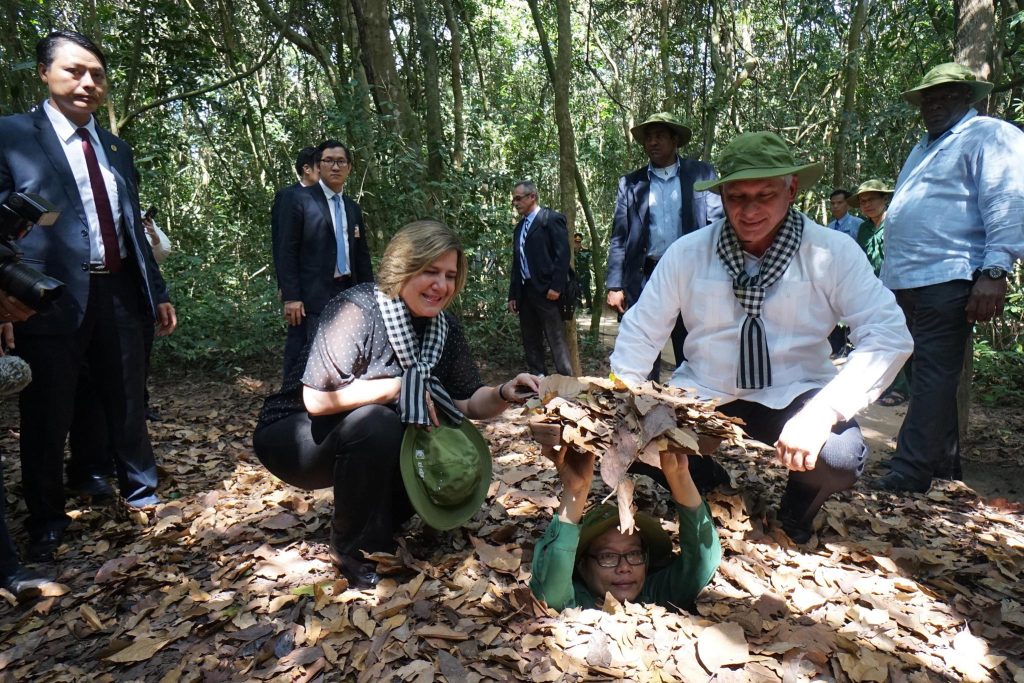Besides being the hustle and bustle of an economic hub, Ho Chi Minh City (Saigon) embraces historical vestiges appealing to both domestic and international tourists. Cu Chi Tunnels are one of the most significant relics of the city.
Cu Chi Tunnels of Sai Gon are honored in the top 7 most adventurous destinations in Southeast Asia and top 12 most attractive underground wonders in the globe. The decades-old tunnel complex resembles a sophisticated hidden maze, where visitors can glimpse the turbulent Vietnamese history as if they are traveling back to the wartime.
Cu Chi Tunnels are situated in Cu Chi district – the outskirts northwest of Ho Chi Minh city, 70 kilometers away from the city center. The underground networks are well-retained in two spots: Ben Dinh Tunnels and Ben Duoc Tunnels.
Despite the far distance from the vibrant center, this suburban district is worth visiting for its several tourist destinations along with the tunnel networks, such as fresh fruit gardens, Cu Chi Water Park, and Fosaco eco-village.
The Tunnels of Cu Chi, a gigantic underground tunnel system, was originally constructed under the jungle terrain, connecting tunnels among the hamlets and communes during the Indochina war (1945-1954) against the French colonialists. It served as hiding spots for Vietnam revolutionary troops to discreetly commute between regions and evade French scouts.
Stretching to the Cambodian frontier, the system of Cu Chi tunnels used to reach a total length of nearly 250 kilometers, of which 120 kilometers have been well-preserved and available for public visit nowadays. The complex of Cu Chi Tunnels Saigon astounds visitors with its intricate architecture and resilience in the area of clay soil mixed with laterite.
On the ground level, there are hundreds of inventive booby traps and counterfeit bunkers set up to impale and deceive enemies. The entrances to these tunnels are so narrow that only Vietnamese could fit in, with wooden manhole covers camouflaged by leaves.
The underground part of the hidden system features three deep levels where numerous passages are connected through a central axis and extend to the Saigon River. The first level (3 meters underneath the ground) was capable of withstanding chemical warfare, bullets, tanks, and armored vehicles, whilst the second one (6 meters from the ground) could resist the destructive power of bombs. The third level is the deepest (more than 12 meters from the ground). Between the levels, escape hatches were made to counter toxic gas along with unrevealed vents leading to the ground. Communications passages were constructed 0.8~1.2 meters in size with a minimum 1.5 meter-thick roof.
A little-known fact about Cu Chi Tunnels is that Vietnamese soldiers excavated this immense underground network with hundreds of kilometer-long tunnels just by hands and primitive tools. The tunnels’ inner structure is likened to a man-made underground city since it accommodated necessary facilities for a thousand of soldiers and dwellers, such as kitchens, hospitals, schools, theaters, armories, chambers, and command centers.
During the Vietnam war, the network had been expanded into an assembly complex for Communist guerrilla soldiers to house troops, transport communications, and supplies, receive medical treatments, take shelters from aerial bombardment, and mount surprise attacks, after which they could disappear underneath the ground.

As a military headquarters, Cu Chi Tunnels played a pivotal role in the Vietnamese forces’ resistance to the American army in South Vietnam. It served as an isolated stronghold to plan strategies and launch successful military campaigns, notably the victorious Tết Offensive in 1968.
Throughout the country’s turbulent history, these iconic Saigon tunnels witnessed the sufferings in the fierce wars and symbolized the tenacity and resourcefulness of the Vietnamese people.
